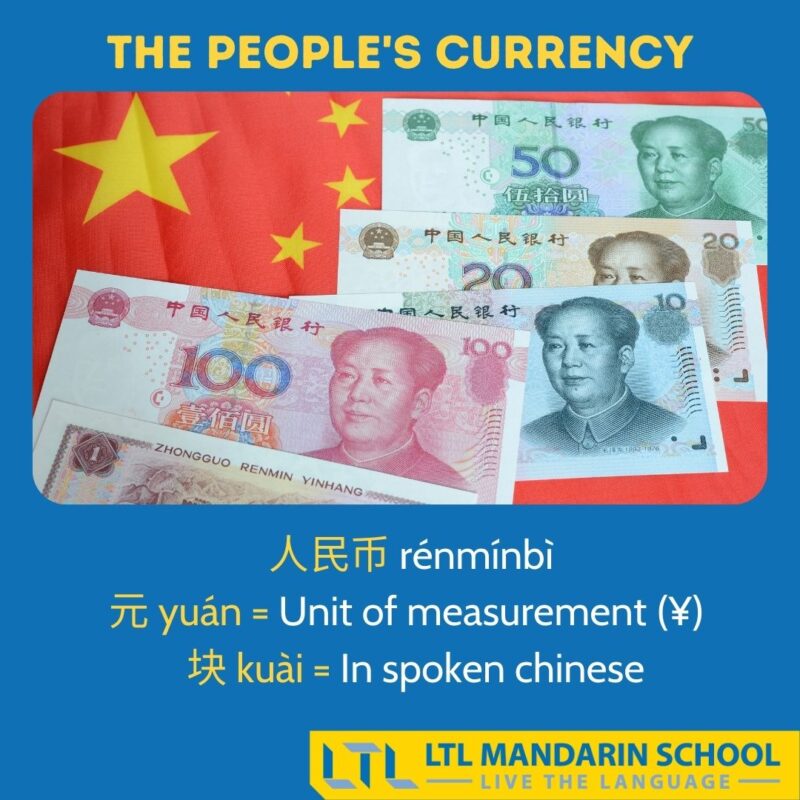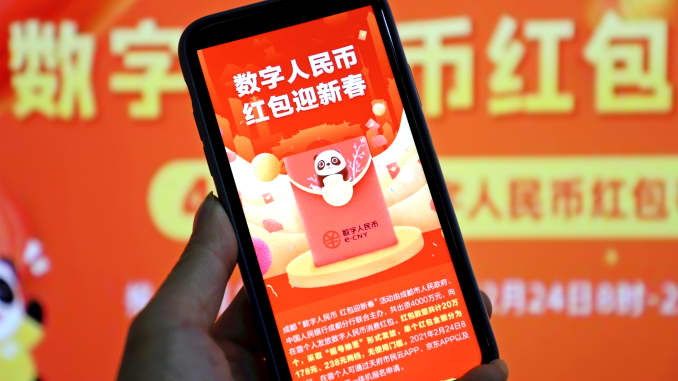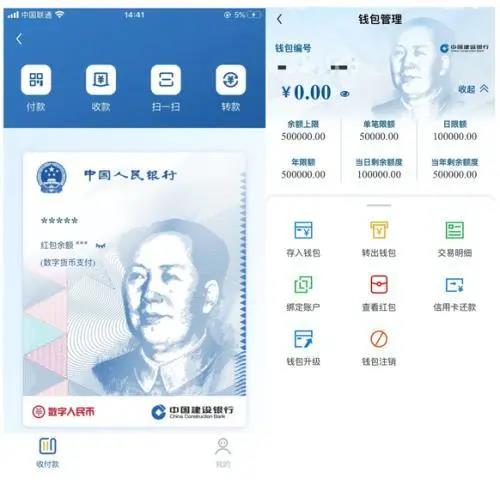The Yuan Goes Digital 🇨🇳 Discovering the Chinese Digital Currency
Since 2014, China has been working on the project of a Chinese Digital Currency (数字货币 shùzì huòbì).

But what exactly is it?
Today, we’ll give you an insight into the currency of the future!
The People’s Bank of China (中国人民银行 Zhōngguó Rénmín Yínháng), has been developing the so-called “Digital Currency Electronic Payment” or simply DCEP (数字货币电子支付 shùzì huòbì diànzǐ zhīfù).
The aim is to replace some of the cash in circulation and make China more and more cashless, something which it is already doing quite well (see the video below for one of many examples)!
In 2019 mobile transactions reached 347 trillion yuan, accounting for four of every five payments.
This means that nowadays, 86% of the Chinese population has abandoned the use of cash.
Are you curious about this digital topic?
Let’s take one step forward together and try to understand Chinese Digital Currency and what implications it could have in the future!
Chinese Digital Currency – What is a Digital Currency?
Chinese Digital Currency – The Chinese Digital Currency Electronic Payment
Chinese Digital Currency – How Does The Chinese Digital Currency Work?
Chinese Digital Currency – When Will The Chinese Digital Currency Launch?
What Is A Digital Currency?
A digital currency is any currency that is exclusively available in electronic form.
The lack of any physical form of currency allows instantaneous and cross-border transactions by using computers or electronic wallets connected to the Internet or a designated network.
Like any other currency, a digital currency can be used to purchase goods (货物 huòwù) as well as services (服务 fúwù).
Digital Currency’s Advantages
The electronic form of the digital currency offers many advantages:
- The transactions are made directly between the parties involved, without any intermediaries
- The transactions are accessible 24/7
- The transactions are instantaneous, occurring in few seconds at a low-cost, with no (or low fees) needed to be paid by the parties
- Excellent record keeping and transparency in all transactions
Types of Digital Currency
Digital currencies exist in a lot of variants, according to their specific features.
To this day, there are three main types of digital currency which are:
| VIRTUAL CURRENCY | CENTRAL BANK DIGITAL CURRENCY | CRYPTOCURRENCY |
|---|---|---|
| An unregulated digital currency controlled by its developers or founding organization. | A digital currency issued by a national/central bank in a regulated form. | A digital currency using a specific technology called blockchain to secure and verify transactions. |
Have you ever heard about blockchain?
Are you curious about it?
Here is a video to explain exactly what a blockchain is
The Chinese Digital Currency Electronic Payment
The Chinese version of a digital currency is called Digital Currency Electronic Payment, in short DCEP (数字货币电子支付 shùzì huòbì diànzǐ zhīfù)
It is also commonly referred as “e-CNY” or “Digital RMB” (数字人民币 shùzì rénmínbì).
The digital RMB is legal tender, having the same value of other forms of yuan, including both notes and coins.

It is the first digital currency to be issued by a major economy, undergoing public testing in 2020.
DID YOU KNOW – Over the last few years, more the 60 countries have experimented with national digital currencies.
Among these include the trials of the digital krona made by Sweden and the Sand Dollar, developed by the Bahamas.
The digital yuan is managed by the People’s Bank of China under a private and centralised system.
As a result, the Chinese digital currency is very different from other virtual currencies which operate under a public and decentralised computer network.
Morover, the digital RMB doesn’t use the blockchain technology like cryptocurrency.
Short History Of The Chinese Digital Currency
The project of a national digital currency can be divided into 4 phases:
- 2014: the People’s Bank of China set up an internal group to study the possibility to develop a digital RMB
- 2016: the Digital Currency Research Institute was created
- 2019: the People’s Bank of China announced that a digital RMB would be released after years of studying
- 2020: testing started in four cities – Shenzhen (深圳 Shēnzhèn), Suzhou (苏州 Sūzhōu), Chengdu (成都 Chéngdū) and Xiong’an (雄安 Xióngān)
Trials have been conducted so far in “closed environments” in order to let the government control their implementations.
For instance, in October 2020 the government carried out a lottery (抽奖 chōujiǎng) to give away 10 million yuan of Chinese digital currency in Shenzhen.
Nearly 2 million people applied and over 47,000 consumers won.
The randomly selected Shenzhen residents received a digital red packets (红包 hóngbāo), containing 200 yuan in a dedicated app.
In total, over 8.8 million yuan was spent during the first week-trial of e-CNY.
In December 2020, the government of Suzhou also gave away 20 million yuan to residents to test the e-yuan.
A second trial took place in Shenzhen in January 2021 involving 20 million yuan.
Many Chinese companies such as JD.com (京东 Jīngdōng), Meituan (美团 Měituán) and Didi ( 滴滴出行 Dīdī chūxíng) also joined the trials.
So far, the trials have expanded to include 10 cities and covering 10 million people.
How Does The Chinese Digital Currency Work?
The Chinese digital currency operates through a two-tier system.
First, the PBOC issues the digital RMB to commercial banks (商务银行 shāngwù yínháng).
These banks distribute the digital RMB to people.
At this stage, consumers would have downloaded an electronic wallet application, authorised by the PBOC and linked to a bank account (银行账户 yínháng zhànghù), to start to pay or receive digital RMB simply using their smartphone.
To spend the money, users simply scan (扫 sǎo) a retailer’s QR code (二维码 èrwéimǎ) or produce a QR code that the retailer can scan.
DID YOU KNOW – Unlike WeChat or Alipay, the Chinese Digital Currency Electronic Payment can work even without an Internet connection.
Additionally, through the function “touch and touch“, two users can simply touch their smartphones to make a transfer.
Crazy right?!
When Will Chinese Digital Currency be Launched?

Although China is pushing forward its experiment in creating a Chinese digital yuan, there is no official date about when it will be released nationwide.
The next step for China is the 2022 Beijing Winter Olympics (2022 北京奥林匹克运动会 Běijīng àolínpǐkè yùndònghuì).
China wants to make digital RMB available not only to domestic users but also international athletes and visitors.
Will it happen? What do you think about the Chinese Digital Currency? Drop us a comment and join the debate below!
Chinese Digital Currency – FAQ’s
What is a digital currency?
A digital currency is any currency exclusively available in electronic form.
What are some advantages in favour of digital currencies?
The transactions are made directly between the parties involved, without any intermediaries.
The transactions are accessible 24/7.
The transactions are instantaneous, occurring in few seconds at a low-cost, with no (or low fees) needed to be paid by the parties.
Excellent record keeping and transparency in all transactions.
Has China got its own digital currency?
China is testing its own national digital currency, called “Digital Currency Eletronic Payment“.
In Chinese this translates to 数字货币电子支付 shùzì huòbì diànzǐ zhīfù
Which cities has China tested its digital currency in?
Testing started in four cities during 2020.
These were Shenzhen (深圳 Shēnzhèn), Suzhou (苏州 Sūzhōu), Chengdu (成都 Chéngdū) and Xiong’an (雄安 Xióngān)
How can people use the Chinese digital currency?
Consumers have to download an electronic wallet application, authorised by the PBOC and linked to a bank account
They can do this by simply using their smartphone.
When will the Chinese digital currency be officially launched?
There is not a date yet, we’ll keep you updated and inform you in this blog when we discover more!
Want more from LTL?
If you wish to hear more from LTL Mandarin School why not join our mailing list.
We give plenty of handy information on learning Chinese, useful apps to learn the language and everything going on at our LTL schools!
Sign up below and become part of our ever growing community!

 Hi, my name is Mojca. I am from Slovenia in Europe and I work as a student advisor at our Beihai school.
Hi, my name is Mojca. I am from Slovenia in Europe and I work as a student advisor at our Beihai school.








4 comments
The world is a changing!
At a fast speed!
Interesting 👀
👀